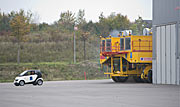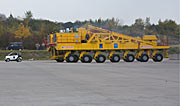Press Release
A Colossus Gets its Name
ALMA Antenna Transporter Presentation
5 October 2007
Today, the first of the two ALMA antenna transporters was given its name at a ceremony on the compounds of the manufacturer, the heavy-vehicle specialist Scheuerle Fahrzeugfabrik GmbH, in Baden-Württemberg. The colossus, 10 metres wide, 20 metres long and 6 metres high, will be shipped to Chile by the end of the month. The second one will follow in a few weeks.
The transporter was named 'Otto' in honour of Otto Rettenmaier, the owner of the Scheuerle company. "The rather unusual move to name a vehicle is a recognition of the remarkable achievement these unique machines represent," said Hans Rykaczewski, the European ALMA Project Manager. "Their sizes alone would justify using superlatives to describe them. But they are also outstanding as they will operate at 5000 metres altitude, where the air is rare, and they have to be able to place 115-ton antennas with a precision of a few millimetres," he added.
"The ALMA antenna transporters are the proof of the excellence of our staff and of our ability to build heavy vehicles that are at the limits of the possible," said Otto Rettenmaier. "Never in the history of our company have we had to comply with such exceptional requirements on material and techniques as we had to do with these machines. We are proud as a company to have been able to contribute with such an exceptional piece of technology for astronomical research."
The ALMA Project, in which ESO leads the construction and the operations on behalf of Europe, is a giant, international observatory currently in construction on the high-altitude Chajnantor site in Chile, which will be composed initially of 66 high-precision telescopes, operating at wavelengths of 0.3 to 9.6 mm. The ALMA antennas will be electronically combined and provide astronomical observations which are equivalent to a single large telescope of tremendous size and resolution.
The 66 antennas of the array can be placed on 192 different pads, covering antenna configurations as compact as 150 metres to as wide as 15 kilometres. Changing the relative positions of the antennas and thus also the configuration of the array allows for different observing modes, comparable to using a zoom lens on a camera.
Given their important functions, both for the scientific work and in transporting high-tech antennas with the required care, the vehicles must live up to very demanding operational requirements. To address these, Scheuerle has developed and built two very special transporters. Building heavy vehicles able to transport with great precision 115-ton antennas is not a problem per se for this company, which specialises in building huge transporters. The problem however was to produce a vehicle able to operate at such a high altitude, where the two engines will lose about half of their power (compared to sea level) because of the reduced oxygen content of the air. With their two 500 kW diesel engines (nearly as much as two Formula 1 engines), the ALMA transporters will be able to move at the speed of 20 km/h when empty and 12 km/h when loaded with an antenna.
Notwithstanding its impressive dimensions, the transporter can be manoeuvred by a single operator, the precise positioning being made possible by a hydrostatic system while the electronic 28-wheel drive allows very precise motions.
"When completed in 2012, ALMA will be the largest and most capable imaging array of telescopes in the world," said Massimo Tarenghi, the ALMA Director. "The ALMA antenna transporters, which are unique technological jewels, beautifully illustrate how we are actively progressing towards this goal."
More information
ALMA will be able to probe the Universe at millimetre and submillimetre wavelengths with unprecedented sensitivity and resolution, with an accuracy up to ten times better than the Hubble Space Telescope, and complementing images made with ESO's Very Large Telescope Interferometer.
ALMA will be the forefront instrument for studying the cool universe - the relic radiation of the Big Bang, and the molecular gas and dust that constitute the very building blocks of stars, planetary systems, galaxies, and life itself.
Because ALMA will observe in the millimetre and submillimetre wavelengths the atmosphere above the telescope must be transparent. This requires a site that is high and dry. ALMA will thus be installed at the 5000m high plateau of Chajnantor in the Atacama Desert of Chile, the world's driest area - the next best location to outer space for these high-accuracy astronomical observations.
The ALMA project is a partnership between Europe, East Asia and North America in cooperation with the Republic of Chile. ALMA is funded in Europe by ESO, in East Asia by the National Institutes of Natural Sciences of Japan in cooperation with the Academia Sinica in Taiwan and in North America by the U.S. National Science Foundation in cooperation with the National Research Council of Canada. ALMA construction and operations are led on behalf of Europe by ESO, on behalf of East Asia by the National Astronomical Observatory of Japan and on behalf of North America by the National Radio Astronomy Observatory, which is managed by Associated Universities, Inc.
Contacts
Stefano Stanghellini
ESO
Garching, Germany
Tel: +49-89-3200-6570
Email: sstanghe@eso.org
About the Release
| Release No.: | eso0745 |
| Legacy ID: | PR 45/07 |
| Name: | ALMA transporters |
| Type: | Unspecified : Technology : Observatory : Telescope |
| Facility: | Atacama Large Millimeter/submillimeter Array |
Our use of Cookies
We use cookies that are essential for accessing our websites and using our services. We also use cookies to analyse, measure and improve our websites’ performance, to enable content sharing via social media and to display media content hosted on third-party platforms.
ESO Cookies Policy
The European Organisation for Astronomical Research in the Southern Hemisphere (ESO) is the pre-eminent intergovernmental science and technology organisation in astronomy. It carries out an ambitious programme focused on the design, construction and operation of powerful ground-based observing facilities for astronomy.
This Cookies Policy is intended to provide clarity by outlining the cookies used on the ESO public websites, their functions, the options you have for controlling them, and the ways you can contact us for additional details.
What are cookies?
Cookies are small pieces of data stored on your device by websites you visit. They serve various purposes, such as remembering login credentials and preferences and enhance your browsing experience.
Categories of cookies we use
Essential cookies (always active): These cookies are strictly necessary for the proper functioning of our website. Without these cookies, the website cannot operate correctly, and certain services, such as logging in or accessing secure areas, may not be available; because they are essential for the website’s operation, they cannot be disabled.
Functional Cookies: These cookies enhance your browsing experience by enabling additional features and personalization, such as remembering your preferences and settings. While not strictly necessary for the website to function, they improve usability and convenience; these cookies are only placed if you provide your consent.
Analytics cookies: These cookies collect information about how visitors interact with our website, such as which pages are visited most often and how users navigate the site. This data helps us improve website performance, optimize content, and enhance the user experience; these cookies are only placed if you provide your consent. We use the following analytics cookies.
Matomo Cookies:
This website uses Matomo (formerly Piwik), an open source software which enables the statistical analysis of website visits. Matomo uses cookies (text files) which are saved on your computer and which allow us to analyze how you use our website. The website user information generated by the cookies will only be saved on the servers of our IT Department. We use this information to analyze www.eso.org visits and to prepare reports on website activities. These data will not be disclosed to third parties.
On behalf of ESO, Matomo will use this information for the purpose of evaluating your use of the website, compiling reports on website activity and providing other services relating to website activity and internet usage.
Matomo cookies settings:
Additional Third-party cookies on ESO websites: some of our pages display content from external providers, e.g. YouTube.
Such third-party services are outside of ESO control and may, at any time, change their terms of service, use of cookies, etc.
YouTube: Some videos on the ESO website are embedded from ESO’s official YouTube channel. We have enabled YouTube’s privacy-enhanced mode, meaning that no cookies are set unless the user actively clicks on the video to play it. Additionally, in this mode, YouTube does not store any personally identifiable cookie data for embedded video playbacks. For more details, please refer to YouTube’s embedding videos information page.
Cookies can also be classified based on the following elements.
Regarding the domain, there are:
- First-party cookies, set by the website you are currently visiting. They are stored by the same domain that you are browsing and are used to enhance your experience on that site;
- Third-party cookies, set by a domain other than the one you are currently visiting.
As for their duration, cookies can be:
- Browser-session cookies, which are deleted when the user closes the browser;
- Stored cookies, which stay on the user's device for a predetermined period of time.
How to manage cookies
Cookie settings: You can modify your cookie choices for the ESO webpages at any time by clicking on the link Cookie settings at the bottom of any page.
In your browser: If you wish to delete cookies or instruct your browser to delete or block cookies by default, please visit the help pages of your browser:
Please be aware that if you delete or decline cookies, certain functionalities of our website may be not be available and your browsing experience may be affected.
You can set most browsers to prevent any cookies being placed on your device, but you may then have to manually adjust some preferences every time you visit a site/page. And some services and functionalities may not work properly at all (e.g. profile logging-in, shop check out).
Updates to the ESO Cookies Policy
The ESO Cookies Policy may be subject to future updates, which will be made available on this page.
Additional information
For any queries related to cookies, please contact: pdprATesoDOTorg.
As ESO public webpages are managed by our Department of Communication, your questions will be dealt with the support of the said Department.





